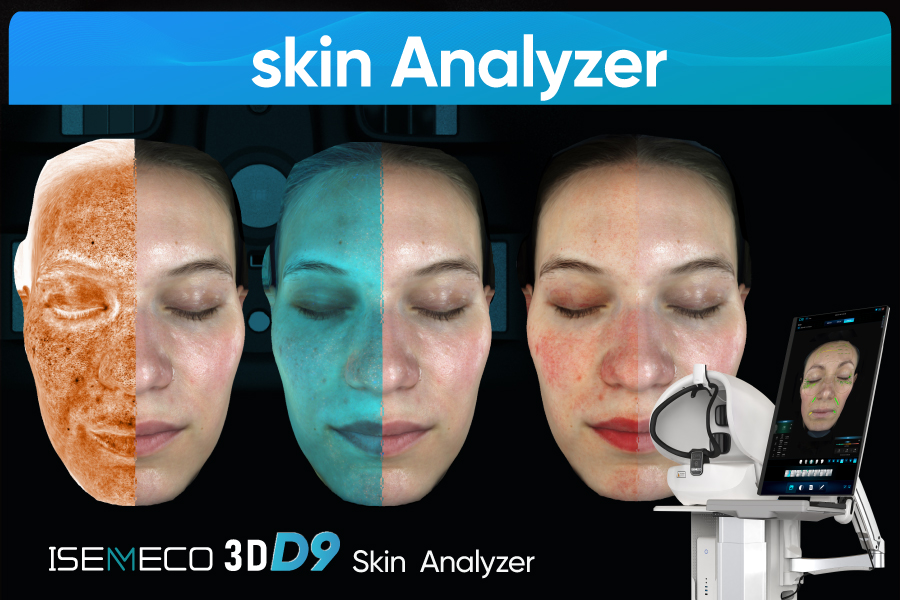The Silent Revolution: How Skin Analyzers Are Rewriting the Rules of Beauty and Health
The modern dermatologist’s office hums with a quiet intensity. Where magnifying glasses once reigned, spectral imaging devices now cast soft glows across faces, capturing subcutaneous secrets invisible to the naked eye. Within moments, a constellation of data materializes—maps of hidden inflammation, UV damage buried beneath the surface, dehydration patterns resembling arid riverbeds. This is the new frontier of skin analysis: a fusion of optics, artificial intelligence, and predictive algorithms transforming how we understand our body’s largest organ.
Beyond Magnification: The Science of Seeing
Skin analyzers have evolved from simple observational tools to diagnostic powerhouses. Early systems relied on surface-level visual assessment, but today’s platforms employ multi-spectral imaging to decode the skin’s layered language. Polarized light exposes subsurface redness and vascular irregularities; UV imaging uncovers accumulated photodamage long before it surfaces as hyperpigmentation; cross-polarized filters highlight texture deviations and early scarring. The result is a biological blueprint that shifts skincare from generic regimens to hyper-personalized interventions.
The most advanced systems function as both detectives and oracles. They quantify oil-water balance to classify skin types accurately—preventing pore-clogging or barrier-disrupting product choices. More crucially, they offer predictive insights: melanin concentration mapping forecasts pigmentation risks, enabling preemptive care; wrinkle trajectory analysis distinguishes dynamic expression lines from structural aging; pore assessments evaluate blockages and shape abnormalities contributing to congestion. Inflammation detection identifies subclinical acne or rosacea triggers before visible flare-ups occur, while hydration algorithms differentiate surface dehydration from impaired barrier function—a distinction determining whether to hydrate or repair.
The Evolving Skin Analyzer Ecosystem
The technology spectrum now ranges from accessible tools to clinical-grade stations:
Handheld AI Scanners: These portable devices leverage smartphone cameras for instant moisture, oil, and acne scoring, democratizing analysis in retail settings and virtual consultations.
Multi-Spectral Stations: Flagship analyzers deploying UV, RBX, and polarized light to scan epidermal and dermal layers, standard in medical spas treating photodamage or sensitivity.
Total Body Mappers: Revolutionary units scanning limbs and torsos to track lesions, psoriasis progression, or body-wide hyperpigmentation, enabling holistic dermatology.
At-Home Diagnostic Partners: Emerging consumer devices with clinical-grade optics, empowering daily microbiome management and progress tracking between professional visits.
The Predictive Pivot
The most significant leap lies in skin analyzers’ predictive capabilities. By integrating 3D simulations and behavioral pattern analysis, high-end systems project skin trajectories years ahead based on current damage and lifestyle factors. This shift from reactive to preventive care is reshaping beauty paradigms. Some clinics now employ analyzers that compare scans against global databases, flagging rare patterns suggestive of premalignant changes—prompting critical medical referrals even when physical symptoms are absent.
Beyond aesthetics, this technology is bridging beauty and systemic health. Nutritionists leverage hydration and inflammation data to refine dietary plans; oncologists track radiation-induced skin changes; endocrinologists correlate hormonal fluctuations with sebum production shifts. In elder care, portable analyzers monitor skin fragility and wound-healing potential, transforming the surface into a diagnostic window for overall wellbeing.
The Invisible Made Actionable
Modern skin analyzers excel at quantifying the imperceptible. They detect “invisible” UV spots before they surface as pigmentation, map subsurface vascular networks to assess inflammation, and identify bacterial byproducts (porphyrins) that contribute to acne. This capacity to reveal hidden stressors allows for earlier, more targeted interventions—whether adjusting sunscreen formulations, modifying cleansers, or introducing barrier-supporting actives.
The newest generation also transcends facial analysis. Full-body scanners track conditions like psoriasis across limbs and torso, while allergy-assessment tools guide patients through self-applied patch tests monitored via smartphone. These systems capture temporal reactions to irritants, compiling data that assists clinicians in pinpointing contact dermatitis triggers without multiple office visits.
Tomorrow’s Skin Intelligence
Next-generation skin analyzers in development promise deeper disruption. Hyperspectral imaging research explores transdermal detection of biomarkers like glucose or cholesterol. AI prediction models may soon interface with personal devices—alerting dermatologists or even smart refrigerators to potential nutritional deficiencies before users sense discomfort. The once-niche beauty tool now challenges preventive medicine paradigms, proving that the most revealing health insights often lie at the surface.
What began as a tool to recommend serums now illuminates our fundamental relationship with the body’s most honest canvas. As skin analyzers grow more intuitive and integrated, they promise a future where skincare isn’t just about looking better—but understanding ourselves more profoundly.
by Irina
Post time: Jul-31-2025









